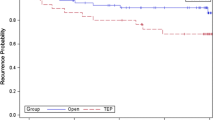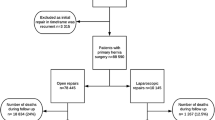Abstract
The risk of intra-abdominal intestinal obstruction after open or laparoscopic hernioplasty is, to our knowledge, not known. The transabdominal laparoscopic (TAPP) route brings a potential risk of abdominal adhesions, which may increase the risk of postoperative intestinal obstruction. The pre-peritoneal route laparoscopically, totally extraperitoneal laparoscopic hernioplasty (TEP), should not increase this risk since the abdominal cavity is not entered. The Swedish Hernia Register, with 33,275 patients operated on for single primary unilateral groin hernia during the period 1992–2000, was linked to the Swedish Inpatient register and the Swedish Death register for the period 1987–2000. The risk of postoperative intestinal obstruction was low, 1.02 per 1,000 personyears. The highest adjusted relative risks (RR) were found in patients with previous admissions for abdominal inflammations or operations. The risk increased with the number of admissions. After an acute operation, and in patients older than 60 years, there was also a significantly increased risk. The RR was 2.79 (95% CI 1.01–7.42) after TAPP and 0.57 (95% CI 0.07–4.33) following TEP compared to patients operated on by the Lichtenstein method. None of the patients undergoing open hernia operations had a significantly increased risk. TAPP increased the risk of postoperative intestinal obstruction, but other risk factors, especially previous abdominal surgery or inflammation, have greater influence.


Similar content being viewed by others
References
Condon RE, Nyhus LM (1995) Complications of Groin Hernia. In: Condon RE (ed) Hernia, 4th edn. J.B. Lippincott Company, Philadelphia, pp 269–282
Nilsson E, Haapaniemi S (1998) Hernia registers and specialization. Surg Clin North Am 78:1141–1155
Collaboration TEHT (2000) Laparoscopic compared with open methods of groin hernia repair: systematic review of randomized controlled trials. Br J Surg 87:860–867
Collaboration TEHT (2000) Mesh compared with non-mesh methods of open groin hernia repair: systematic review of randomized controlled trials. Br J Surg 87:854–859
Bay-Nielsen M, Nordin P, Nilsson E, Kehlet H (2001) Operative findings in recurrent hernia after a Lichtenstein procedure. Am J Surg 182:134–136
SHR (2002) Svenska bråckregistret årsrapport 2001 (Swedish Hernia Register Annual Report 2001), Motala, Sweden
Collaboration TEHT (2002) Repair of groin hernia with synthetic mesh: meta-analysis of randomized controlled trials. Ann Surg 235:322–332
Felix EL, Michas CA, Gonzalez MH Jr (1995) Laparoscopic hernioplasty. TAPP vs TEP. Surg Endosc 9:984–989
Bendavid R (1998) Complications of groin hernia surgery. Surg Clin North Am 78:1089–1103
Eugene JR, Gashti M, Curras EB, Schwartz K, Edwards J (1998) Small bowel obstruction as a complication of laparoscopic extraperitoneal inguinal hernia repair. J Am Osteopath Assoc 98:510–511
Lodha K, Deans A, Bhattacharya P, Underwood JW (1998) Obstructing internal hernia complicating totally extraperitoneal inguinal hernia repair. J Laparoendosc Adv Surg Tech A 8:167–168
Miller G, Boman J, Shrier I, Gordon PH (2000) Natural history of patients with adhesive small bowel obstruction. Br J Surg 87:1240–1247
Menzies D, Ellis H (1990) Intestinal obstruction from adhesions—how big is the problem? Ann R Coll Surg Engl 72:60–63
Polymeneas G, Theodosopoulos T, Stamatiadis A, Kourias E (2001) A comparative study of postoperative adhesion formation after laparoscopic vs open cholecystectomy. Surg Endosc 15:41–43
Eller R, Bukhari R, Poulos E, McIntire D, Jenevein E (1997) Intraperitoneal adhesions in laparoscopic and standard open herniorrhaphy. An experimental study. Surg Endosc 11:24–28
Duron JJ, Hay JM, Msika S, Gaschard D, Domergue J, Gainant A, Fingerhut A (2000) Prevalence and mechanisms of small intestinal obstruction following laparoscopic abdominal surgery: a retrospective multicenter study. French Association for Surgical Research. Arch Surg 135:208–212
Andersson RE (2001) Small bowel obstruction after appendicectomy. Br J Surg 88:1387–1391
National Board of Health and Welfare Website, Quality of data and underreporting (2002) National board of health and welfare, Available at: http://www.sos.se/epc/english/ParEng.htm
National Board of Health and Welfare Website (2002) Kvalitet i dödsorsaksregistret (Quality in the Causes of Death register), Available at: http://www.sos.se/epc/dors/filer/kvalitet.htm
Acknowledgements
The authors acknowledge SHR surgeons for their collaboration. The SHR has been assembled by representatives from the following surgical units: Arvika, Bollnäs, Eksjö, Eskilstuna, Falköping, Falun, Finspång, Gällivare, Gävle, Frölunda (Göteborg), Lundby (Göteborg), Sahlgrenska University Hospital (Göteborg), Helsingborg, Hudiksvall, Jönköping, Kalix, Kalmar, Karlshamn, Karlskoga, Karlskrona, Katrineholm, Kristianstad-Hässleholm, Lidköping, Lindesberg, Linköping University Hospital, Ljungby, Ludvika, Lund-Landskrona, Lycksele, Mora, Motala, Norrköping, Norrtälje, Oskarshamn, Piteå, Skellefteå, Skene, Ersta (Stockholm), Huddinge University Hospital (Stockholm), S:t Göran (Stockholm), Säffle, Södertälje, Trollhättan, Uddevalla, Uppsala, Varberg, Värnamo, Västervik, Läkargruppen (Örebro) and Östersund. Statistician Lennart Gustafsson has provided invaluable help during the preparation of this manuscript. Financial support for the Swedish Hernia Register has been received from the National Board of Health and Welfare and the Federation of County Councils of Sweden. The study was supported by a grant from the County Council of Stockholm. The authors did not have any conflicts of interest.
Author information
Authors and Affiliations
Corresponding author
Rights and permissions
About this article
Cite this article
Bringman, S., Blomqvist, P. Intestinal obstruction after inguinal and femoral hernia repair: a study of 33,275 operations during 1992–2000 in Sweden. Hernia 9, 178–183 (2005). https://doi.org/10.1007/s10029-004-0305-7
Received:
Accepted:
Published:
Issue Date:
DOI: https://doi.org/10.1007/s10029-004-0305-7




